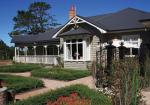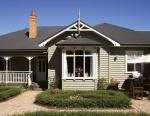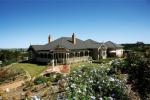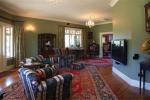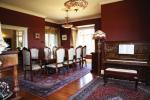The Enchanting Villa
By Graham Hepburn
Computer aided design is a wonderful tool when it comes to building your dream home.
That’s what Tony and Jackie Krzyzewski found when they began playing around with ideas for the home they wanted to build on a section they bought in Whitford about three years ago.
Their original idea was to create a traditional villa but then Tony, with the aid of 3D modeling, came up with a Plan B – a much more grand English colonial-style home.
Excitement was high about the new design – until the Krzyzewski’s had it costed.
“It was going to be a $2 million build,” says Jackie. “That’s when we said, ‘Well, what’s wrong with our original plan of building a villa?’”
However, there was a problem that needed resolving first.
“One of the things I didn’t like about villas was they always seemed to have a dead side of the house,” says Jackie. “I wanted it to be pretty from every side so we ended up with five bay windows to get it the way we wanted it to look.”
On top of that, a portico was also incorporated into the corner of the verandah that wraps around the living room.
Tony, who works with computer systems, says the design took him about two weeks to work through and then he had a major breakthrough.
“I woke up one morning and I said, ‘I know how to do this house now’, and by eight in the morning I had a 3D model – it just all fell into place.”
A natural choice for the roofing was corrugate with the Krzyzewski’s opting for Colorcote® ZR8TM in Ironsand to tie in with the classic colours of the rest of the home. Tony used computer modelling to “drape the roof” and the measurements were bang-on.
“Unless you get the roof right the house won’t work,” says Tony. “It had to be corrugated iron and we wanted to get the roof all in proportion with the rest of the house so we opted for a steeper pitch of roof to give it some presence.”
That steep pitch in combination with the home’s 12 m width means that there’s plenty of headroom if any subsequent owners wanted to add another level below the roofline. The storeroom off the hallway has been designed so that it could be replaced by a staircase if someone did want to go up.
To maintain the classic villa look, the Krzyzewski’s have used brick chimneys – from the roof up anyway – that shroud the metals flues of the gas fires.
Tony says the proportions of the rooms were “heavily defined by the bay windows because they’re a builder’s standard bay”.
And then there was the matter of juggling the layout of the home.
“Because the house is 12m from back to front the biggest problem was trying to work out how to use the internal spaces,” says Tony. “So we created a service core that doesn’t need natural light but all the other rooms have French doors or windows.”
That service core comprises a study, walk-in wardrobe and storage room. The study backs on to the lounge and the couple has cleverly tucked all the audio visual gear and connections in the study that feed the likes of the flat screen TV and sound system, keeping the living spaces uncluttered.
The home has a 3m stud, with stained glass, decorative plaster coving, ceiling roses and mouldings throughout.
“We kept on adding layer upon layer of detail to the house and the house kept sucking it up,” says Tony. “What you’d normally do is only have fancy stuff in the living room - then we thought we’d stretch it to the rest of the house.”
The vestibule has tessellated tiles and archways inviting you down the two wide hallways – one that goes straight ahead past the kitchen to the master suite at the rear, while the other heads off to the right to a wing with the other two bedrooms.
Tony says the home was also built in a traditional manner. “Everything was cut by hand the old-fashioned way,” he says. “There was no pre-framing apart from the roof trusses.”
One of the apprentices spent weeks cutting scriber boards for the weatherboards, and even the cat door in the internal-access garage has been custom-made, complete with architraving.
“The best compliment we received was when another builder visited the site and asked us how the restoration was coming along!”
says Tony.
The only concession the couple made to modernity was having aluminium joinery installed for ease of maintenance. But even that has been specified to match the proportions and style of its wooden counterpart to maintain the traditional villa look.
While the home also has CAT5 and video cabling to every room, you would never know as all the sockets are contained in old-fashioned-looking fittings.
The couple has sourced period furniture and reproduction fittings as part of their determination to make the home look traditional inside and out right down to the paint scheme.
A container load of furniture and fittings – including the fireplaces – came from Australia where there is a huge demand for those character items because the Aussies love doing up their Federation homes.
Jackie spent endless hours on the computer manipulating the placement of furniture within the floorplan to make sure there was a place for everything and everything was in its place.
This attention to detail is obvious in the living room and particularly in the opulent separate dining room, with its period furniture and a rich red and gold colour scheme.
Tony, who is the chef of the household, took command of the kitchen layout and fittings. A large pantry, island bench with pot hanger above it, granite bench tops and a hulking Rangemaster stove are features of the kitchen, which has wide rural views even as you labour over the dishes in the butler’s sink.
The home took 11 months to build but by the time that Jackie and Tony were ready to move in they had the garden pretty much complete. They had started landscaping the garden three years earlier, not long after they bought the section and when the house was finished they had turf laid and the house looked as though it had always been there.
While Jackie and Tony swear they would never take on a build like this again, they still have the 3D sketches of that English colonial home sitting on the computer at home.

